BMW R71
An important development in the history of BMW's long-running flat-twin occurred in 1936 with the introduction of a welded, tubular steel frame on the R5 model, replacing the pressed steel chassis used hitherto. The R5's 500cc overhead-valve engine likewise was new and the following year a 600cc side valve derivative was introduced on the R6, a touring model intended for sidecar duty. In 1938 the R5 and R6 were updated, gaining a telescopic front fork and plunger rear suspension to become the R51 and R61, while the range was further extended by the introduction of a bored-out-to-750cc version of the latter – the BMW R71. The R71 engine only produced a relatively modest 22bhp but its biggest virtue was exceptional flexibility, which was just what its intended market required. Approximately 1,800 R71s had been made by the time production ceased in 1941. Post-war the design was revived in the USSR as the Ural.
In Media[edit | edit source]
| |||||||||||||||||
 |
|
| BMW R71 | |
| Manufacturer | |
|---|---|
| Also called | R 71 |
| Production | 1938 - 1941 |
| Class | Classic |
| Engine | two cylinder boxer, four-stroke |
| Bore / Stroke | 78.0mm x 78.0mm |
| Compression ratio | 5.5:1 |
| Top Speed | 78 mph (125 km/h) |
| Horsepower | 21.59 HP (16.1 KW) @ 4600RPM |
| Transmission | Gear box: 4-speed Final Drive: shaft drive (cardan) |
| Suspension | Front: cartridge Rear: twin shock-swingarm |
| Brakes | Front: expanding brake (drum brake). single Rear: expanding brake (drum brake) |
| Front Tire | 3.5-19 |
| Rear Tire | 3.5-19 |
| Wheelbase | 55.12 inches (1400 mm) |
| Length | 83.86 inches (2130 mm) |
| Width | 32.09 inches (815 mm) |
| Height | 37.8 inches (960 mm) |
| Weight | 187.0 kg (wet) |
| Fuel Capacity | 3.7 Gallon (14.00 Liters) |
| Fuel Consumption | 4.50 liters/100 km (22.2 km/l or 52.27 mpg) |
| Manuals | Service Manual |
The BMW R71 was a two cylinder boxer, four-stroke Classic motorcycle produced by BMW between 1938 and 1941. It could reach a top speed of 78 mph (125 km/h). Claimed horsepower was 21.59 HP (16.1 KW) @ 4600 RPM.
Engine[edit | edit source]
The engine was a air cooled two cylinder boxer, four-stroke. A 78.0mm bore x 78.0mm stroke result in a displacement of just 746.0 cubic centimeters. Fuel was supplied via a overhead valves (ohv).
Drive[edit | edit source]
The bike has a 4-speed transmission. Power was moderated via the dry-single plate-cable operated.
Chassis[edit | edit source]
It came with a 3.5-19 front tire and a 3.5-19 rear tire. Stopping was achieved via expanding brake (drum brake). single in the front and a expanding brake (drum brake) in the rear. The front suspension was a cartridge while the rear was equipped with a twin shock-swingarm. The R71 was fitted with a 3.7 Gallon (14.00 Liters) fuel tank. The wheelbase was 55.12 inches (1400 mm) long.
1938 - 1941 BMW R 71[edit | edit source]
The 1938 BMW R 71 is one of the most powerful machines designed by the House of Munich up to date. It sports an air-cooled, four-stroke, 746cc, boxer twin cylinder powerhouse mated to a four-speed manual transmission and can produce a claimed 22 horsepower at 4600 rpm. Standard features include full-fenders, a rear, fender-mounted luggage rack, laced wheels, a dual exhaust system, a telescopic front fork, plunger shocks, a sprung single seat and a large, round headlight. In addition, it can be fitted with a sidecar.
In Media[edit | edit source]
- Tajemnica twierdzy szyfrów
- Misja
- Otryad
- Pojazdy powstanczej Warszawy
- Stawka wieksza niz zycie
- Inglourious Basterds
- Dom
- Un singe en hiver
- Tutti figli di Mammasantissima
- Shumatsu no Izetta
- Magyar Vándor
- Farbfilme aus dem Dritten Reich
- Obsluhoval jsem anglického krále
- Island at War
- Joanna
- Soviet Storm: WWII in the East
- Na vseki kilometar
- Zamach
- Nad Tissoy
- Victory
- The History of BMW: The Definitive Story
- Horrors of War
- General Nil
- Vive la France
- Die Brücke
- Italiani brava gente
- Karol. Czlowiek, ktory zostal papiezem
- The Last Emperor
- Gli sbandati
- Spy Sorge

